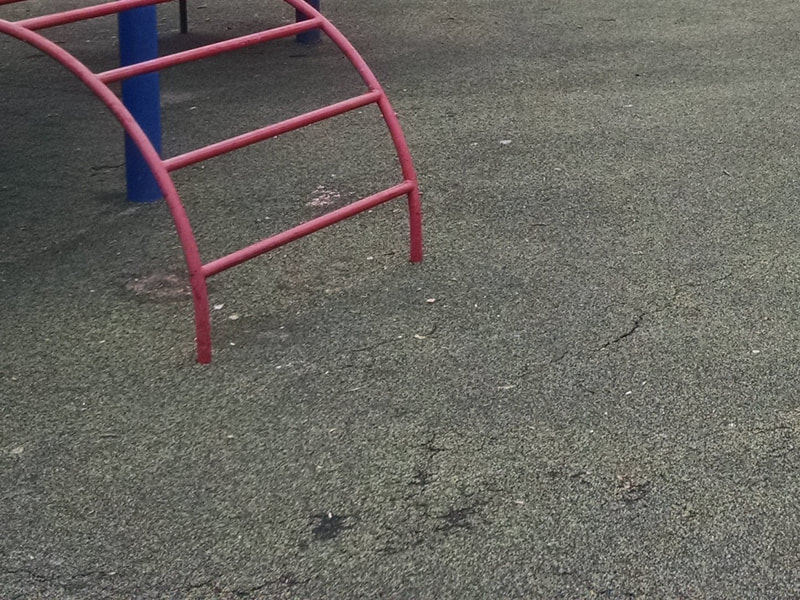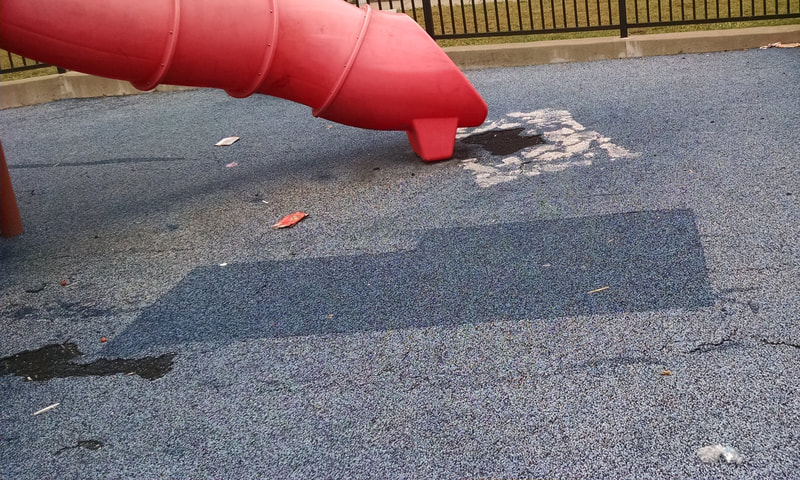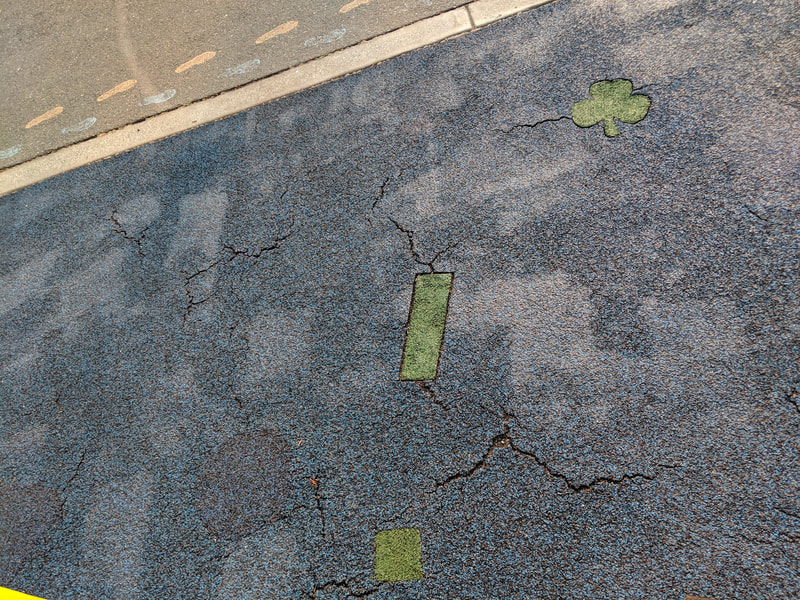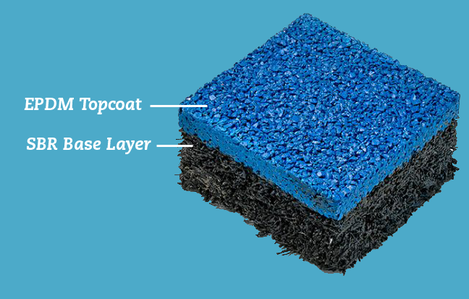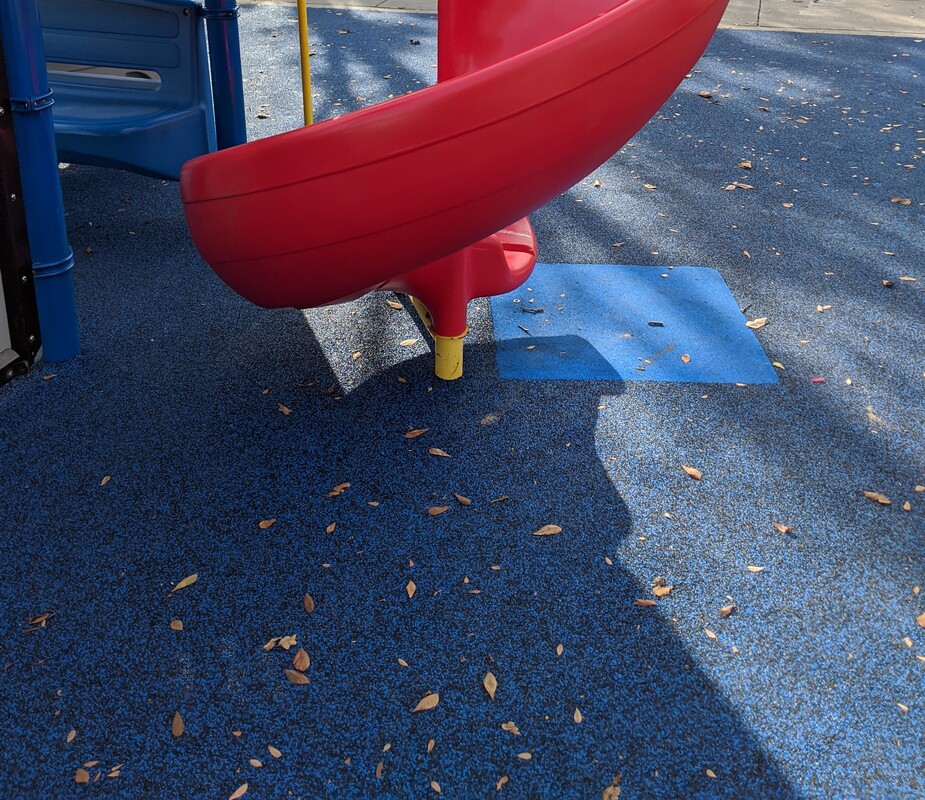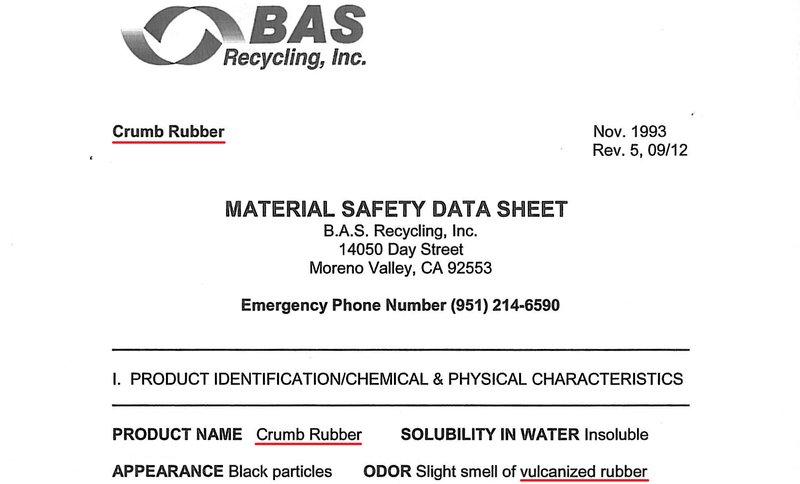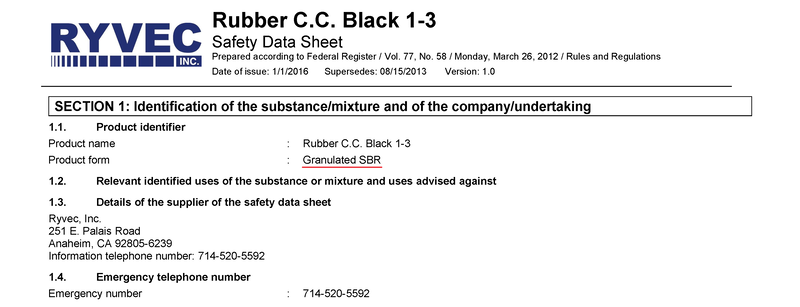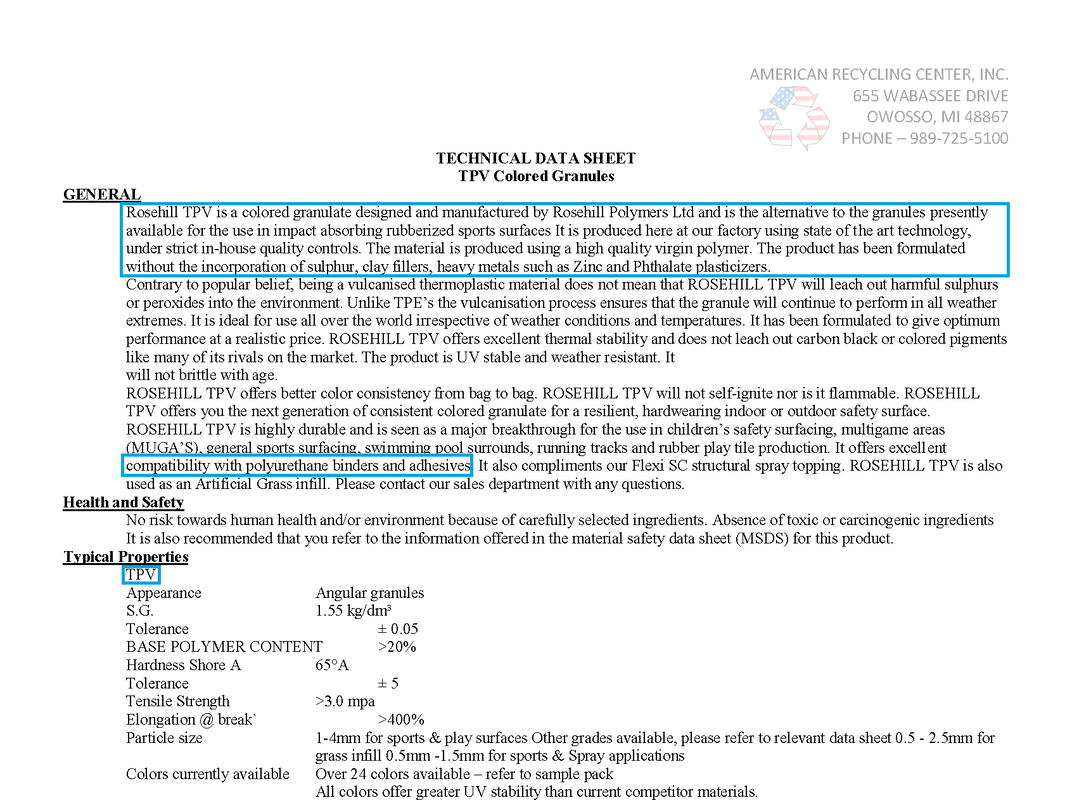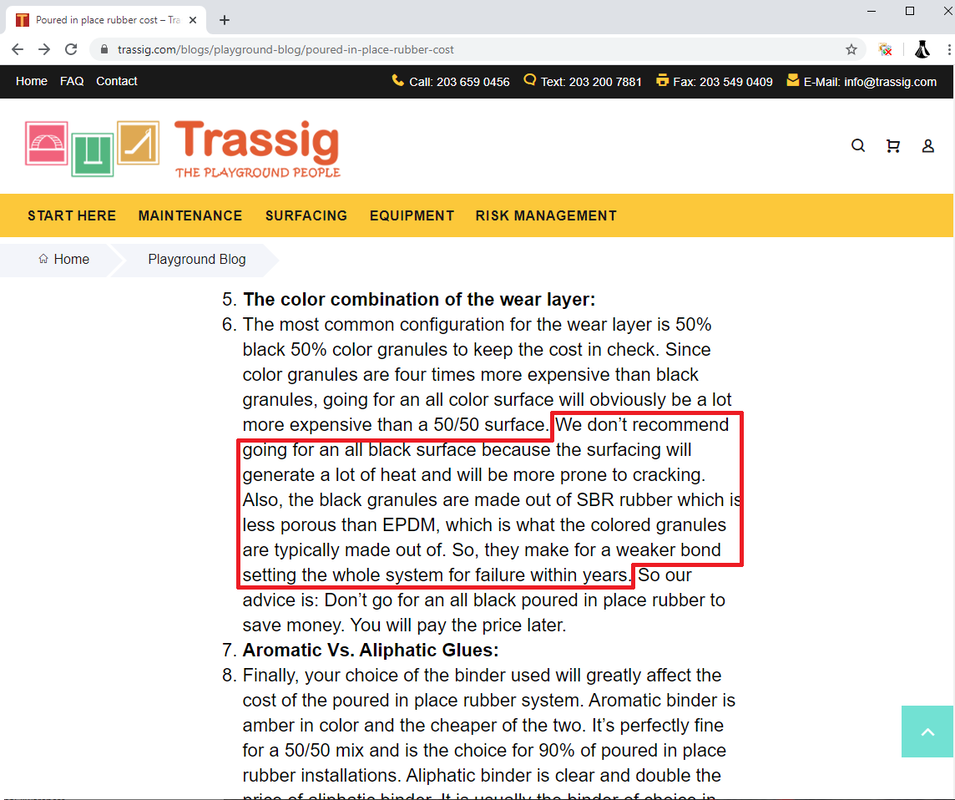Poured in Place rubber is currently the most sought after playground surface.
An installation method referred to as 50/50 (half color / half black) is growing in popularity.
It comes with reduced upfront costs, but is it worth it?
Below is a detailed explanation of why we try to avoid burdening our clients with this type of playground surfacing.
An installation method referred to as 50/50 (half color / half black) is growing in popularity.
It comes with reduced upfront costs, but is it worth it?
Below is a detailed explanation of why we try to avoid burdening our clients with this type of playground surfacing.
50/50 rubber - the bottom line
50/50 Poured-in-Place rubber costs less at first, but costs a lot more in the long run when it fails and must be replaced!
According the to the manufacturer, the black granule in 50/50 rubber is "reclaimed... post-industrial scrap rubber".
The black granule is typically ground up SBR (car tire rubber). The recipe for Poured-in-Place Rubber was carefully engineered with an EPDM/TPV granule, not SBR. Black scrap rubber is the wrong ingredient.
Summary:
We can't expect success from the 50/50 recipe when we've substituted an ingredient that is less controlled, and also the wrong ingredient.
According the to the manufacturer, the black granule in 50/50 rubber is "reclaimed... post-industrial scrap rubber".
The black granule is typically ground up SBR (car tire rubber). The recipe for Poured-in-Place Rubber was carefully engineered with an EPDM/TPV granule, not SBR. Black scrap rubber is the wrong ingredient.
Summary:
We can't expect success from the 50/50 recipe when we've substituted an ingredient that is less controlled, and also the wrong ingredient.
'original' Poured-in-Place Rubber
Prior to about a 15 years ago, all "Poured in Place" rubber playgrounds were essentially installed the same way.
base layer:
The bottom layer of the rubber is responsible creating the bounciness. It can be installed with different thicknesses depending on how much protection is required, but, more often than not, it's a couple inches thick. This is referred to as the base layer or impact attenuation layer and is a mix of binder (glue) and SBR rubber (usually called Rubber Buffings). The buffings are a great way to make use of old recycled tires. The finished result resembles a black rubber bird's nest.
The bottom layer of the rubber is responsible creating the bounciness. It can be installed with different thicknesses depending on how much protection is required, but, more often than not, it's a couple inches thick. This is referred to as the base layer or impact attenuation layer and is a mix of binder (glue) and SBR rubber (usually called Rubber Buffings). The buffings are a great way to make use of old recycled tires. The finished result resembles a black rubber bird's nest.
|
topcoat:
The upper layer of rubber is responsible for looking pretty and withstanding foot traffic. Without it, the tire scrap base layer would look terrible, and probably smell pretty bad on hot days. It would get way too hot, and break apart almost immediately. Hence the need for a top layer. This upper layer is called the Topcoat or Wear Course, and is almost always installed at a thickness of 1/2 inch. In the early days, this layer was a mix of binder (glue) and EPDM. EPDM granules are the colorful crumbs that create the snazzy finished look of the Poured in Place system. |
'modern' Poured-in-Place rubber
what has changed in the last decade?
The Base Layer is largely unchanged. There are alternatives to the shredded rubber base, (i.e. rubber chunks, shredded foam, etc.) but most installers are still putting it down in exactly the same way as before.
The Topcoat has seen some improvements over the years. EPDM is still very popular, but the next generation of granules, TPV, offers more vibrant colors, better UV color stability and a reduced tendency to harden and crack. Both EPDM and TPV will last a long time if installed and maintained properly.
The most significant change to the topcoat in the last decade is the introduction of 50/50 Poured-in-Place rubber.
The Base Layer is largely unchanged. There are alternatives to the shredded rubber base, (i.e. rubber chunks, shredded foam, etc.) but most installers are still putting it down in exactly the same way as before.
The Topcoat has seen some improvements over the years. EPDM is still very popular, but the next generation of granules, TPV, offers more vibrant colors, better UV color stability and a reduced tendency to harden and crack. Both EPDM and TPV will last a long time if installed and maintained properly.
The most significant change to the topcoat in the last decade is the introduction of 50/50 Poured-in-Place rubber.
what is 50/50 Poured in Place Rubber?
The term 50/50 is used to indicate a topcoat that is half 'Color' and half 'Black'. This means that half the topcoat is EPDM/TPV granules and the other half is "Black" Rubber or SBR granules.
The term 50/50 is used to indicate a topcoat that is half 'Color' and half 'Black'. This means that half the topcoat is EPDM/TPV granules and the other half is "Black" Rubber or SBR granules.
why 50/50? Why is SBR being substituted for EPDM/TPV?
Price! Installers like myself pay a little over a dollar per pound for EPDM/TPV. Alternatively, I can purchase black SBR granules for about a quarter per pound. The material cost savings of 50/50 Rubber usually allows the prospective installer to come in with a price that is usually a couple dollars less than their competitors. Unfortunately, the added cost of premature failure and replacement far offset the upfront savings.
Price! Installers like myself pay a little over a dollar per pound for EPDM/TPV. Alternatively, I can purchase black SBR granules for about a quarter per pound. The material cost savings of 50/50 Rubber usually allows the prospective installer to come in with a price that is usually a couple dollars less than their competitors. Unfortunately, the added cost of premature failure and replacement far offset the upfront savings.
if it's cheaper, and everyone is doing it, what's so bad about 50/50?
The million dollar question!
EPDM / TPV - These 'color' granules are manufactured specifically to be installed in this application. They are engineered to bind with the glue and create a resilient topcoat for playground rubber.
SBR - The 'black' granules are scraps from rubber factories. They are not specifically manufactured to act as a playground surface. They are not engineered to be compatible with the glue. If SBR was an ideal product for this application, we could just leave the lower layer exposed to the elements and let that act as our protective surfacing. It wouldn't be as pretty, but certainly some budget conscious playground owners wouldn't mind so long as it did the job. SBR 'Black' granules are only popular because they are cheap leftovers. But since, they were never designed for this application, they just don't hold up. They detach from the binder and cause the entire topcoat to fail. Rub your hand over a 50/50 playground. If it was installed more than a year or so ago, you will feel all the loose granules.
The million dollar question!
EPDM / TPV - These 'color' granules are manufactured specifically to be installed in this application. They are engineered to bind with the glue and create a resilient topcoat for playground rubber.
SBR - The 'black' granules are scraps from rubber factories. They are not specifically manufactured to act as a playground surface. They are not engineered to be compatible with the glue. If SBR was an ideal product for this application, we could just leave the lower layer exposed to the elements and let that act as our protective surfacing. It wouldn't be as pretty, but certainly some budget conscious playground owners wouldn't mind so long as it did the job. SBR 'Black' granules are only popular because they are cheap leftovers. But since, they were never designed for this application, they just don't hold up. They detach from the binder and cause the entire topcoat to fail. Rub your hand over a 50/50 playground. If it was installed more than a year or so ago, you will feel all the loose granules.
installers in my area are doing almost exclusively 50/50 playgrounds.
do you know something they don't?
do you know something they don't?
|
This is a picture of a brand new, Poured in Place rubber installation. The installer is one of the most popular rubber installers in this area. The entire playground has been installed with 50/50 (half color/ half black) rubber mix. The high traffic locations (slide exits, and staircase entry points) have large full color squares. These are not patches. They are all part of the same installation. It is hard to interpret this installation technique as anything other than a confession of a faulty product. To me, this is an indication that the installer is well aware that the 50/50 rubber will fail within the warranty period, and hopefully by putting in a better product in the areas most likely to fail, they can avoid the repair expenses. If the 50/50 rubber were just as durable, I can't think of a reason they would want non-matching slabs all over the new playground.
|
50/50 mix - documentation
Here are manufacturer-provided spec sheets for the black granules in the 50/50 mix. To be clear, these are excellent manufacturers and I happily install their products regularly. My goal is not to disparage the manufacturers in any way, but instead to illustrate the composition and origins of the black granules. It is important to make clear that the black granules are not simply non-colored versions of the EPDM / TPV product. They are simply black scrap rubber left over from non-playground related manufacturing.
|
In contrast, here is the manufacture-provided spec for TPV. Unlike the black rubber, it is very clear that this product is produced from start to finish by the manufacturer for the specific application of playground surfacing. Unlike the black rubber, it is specified that the product is compatible with the binder that will be used to install the product. Unlike the black rubber, the words "childrens's safety surfacing' are indicated right in the data sheet. |
|
Here is an excerpt from a rubber installer's website. The installer has claimed that an all black installation is a bad choice, because black rubber does not bond well and will result in a full system failure. I completely agree. However, I would think we could take this logic a step further. If we agree that black rubber causes failure, why would use if for 50% of our mix. Wont that mean that 50% of our topcoat will fail? |

